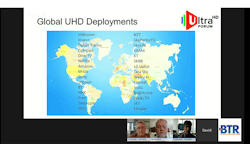By: Steve Christian, SVP of Marketing, Verimatrix
Some technologies never escape the “trough of disillusionment” that follows the initial hype, using Garner’s famous lifecycle model. That was the fate of 3D TV, which failed to deliver a sufficient “wow” factor to persuade consumers it was worth the cost, never mind the inconvenience of viewing through glasses.
We can now say almost certainly that Ultra HD TV has progressed beyond the trough and is starting to climb the slope of enlightenment towards the final “plateau of productivity.” But it has taken a major shift in focus to make that escape, as was highlighted clearly at the recent insightful BTR Hangout, where I joined Mark Francisco from Comcast’s Innovation Labs and the Ultra HD Forum’s VP David Price to thrash out the implications for pay-TV operators.
Several key messages emerged from the Hangout, with Price echoing a fast growing consensus when he insisted that UHD had become so much more than just 4K, which is now taken just to describe the higher 2160 x 3840 pixel resolution.
He pointed out how UHD was now a combination of wide color gamut (WCG) and high dynamic range (HDR), as well as the optical transfer function that is less often discussed but crucial for delivering the full UHD experience to the end device. Optical transfer function complements HDR and WCG by providing the signaling that transmits contrast through the transmission chain and enables pixels to be changed rapidly between light and dark on the end device to reveal fine detail within the picture.
There is a growing conviction within the industry that HDR, WCG and optimized optical transfer between them deliver a greater improvement to the viewing experience than 4K resolution alone, for only a modest increase in overall video bandwidth. Price noted that early findings from a survey conducted by the UHD Alliance revealed that some consumers considered 1080p HD with HDR as superior to 4K without HDR.
However, all of us at the Hangout agreed these were early days for UHD with the practical implementation challenges still being hashed out. The wider Ultra HD Premium branding – launched at CES this year – includes 4K, high frame rate (HFR), up to 60 fps or more, and object based surround sound.
These will all become part of the next generation immersive experience whose definition will be enhanced further in a second phase of Ultra HD Premium due to be released by the UHD Alliance in 2017. We agreed that mainstream UHD deployments will only come after that as compliant components across the ecosystem become widely available.
My perspective is that some content services and TV makers have potentially sowed the seeds of considerable consumer confusion around early 4K resolution services and TV sets, by describing them as delivering the full UHD experience. However, Price pointed out that excellent Ultra HD Premium TVs are now available from LG, Sony and others – and that these TVs are starting to deliver the high impact experience that consumers will demand of a new premium service tier. Though he also admitted that he was waiting for a little more certainty over the course of UHD – or perhaps a drop in the cost - before buying an HDR-capable TV set himself.
Some operators are showing similar reticence at the level of pay-TV services, with Sky Italia indicating it will delay introduction of UHD services until it can include the additional components such as HDR (set to launch in 2017). Indeed there are several significant challenges to be resolved before full commercial UHD services can be rolled out. Most of these hurdles revolve around workflow rather than network bandwidth, according to Francisco of Comcast.
He argued that cable operators that had migrated to DOCSIS 3.0 had plenty of capacity to deliver UHD video, but it was harder to establish efficient end to end delivery. He pointed out that Comcast was looking towards single capture for delivery to all generations of TV, including HD, HDR, standard dynamic range, standard definition and 4K. The goal is unified workflow, taking master quality content from the suppliers and going through just one compression step with the HEVC codec to serve all target platforms.
This would still leave a major challenge incorporating legacy content with UHD without jeopardizing the user experience. This could arise for example during a broadcast of the Olympic Games in UHD where a clip from the event four years earlier in say HD or even SD is shown. The same might arise when stitching an HD ad into a UHD stream. In both cases, this would lead to a discontinuity in quality, even to an extent where the lower quality content is up-scaled.
Another question we touched on at the Hangout was the extent to which UHD standards might need upgrading in future. This arises in the context of HDR, where the current specification is for a peak brightness of 1000 nits, compared with 100 to 400 nits for most TVs today. Dolby among others has made a case for going as high as 4000 nits in future but Price admitted this could make it hard to meet energy consumption targets and would for the same reason increase the drain on batteries for portable devices such as tablets.
Another major challenge, of course, is security. I explained how Verimatrix had incorporated the requirements outlined by MovieLabs in its mandate for UHD content in the VCAS™ Ultra platform, specifying a system that combines the three security pillars of trusted software, a hardware-based root of trust and forensic watermarking. These combine to enable illicit streams to be identified and taken down quickly while ensuring that security is renewable.
Previous security regimes associated with HD, which appeared strong enough at the time, have sometimes subsequently failed to protect against piracy as the sophistication of the threat model evolved. It is therefore essential that security can be upgraded effectively in the field, enabling the industry to stay one step ahead of the pirates.
Security is already playing a key role enabling operators to trial UHD as a premium tier including high value content. Operators can now start demonstrating that “wow” factor needed to convince customers the premium for services and CPE is worth paying. As the Hangout confirmed, 4K alone is not enough to deliver that “wow” factor.
You can watch the Hangout on demand and share your comments on how video service providers can best prepare for UHD launches.
About Sponsor
Verimatrix specializes in securing and enhancing revenue for multi-network, multi-screen digital TV services around the globe and is recognized as the global number one in revenue security for connected video devices. The award-winning and independently audited Verimatrix Video Content Authority System (VCAS™) family of solutions enable next-generation video service providers to cost-effectively extend their networks and enable new business models. The company has continued its technical innovation by offering the world’s only globally interconnected revenue security platform, Verspective™ Intelligence Center, for automated system optimization and data collection/analytics.
Its unmatched partner ecosystem and close relationship with major studios, broadcasters and standards organizations enables Verimatrix to provide a unique advantage to video business issues beyond content security as operators introduce new services to leverage the proliferation of connected devices. Verimatrix is an ISO 9001:2008 certified company. For more information, please visit www.verimatrix.com, our Pay TV Views blog and follow us @verimatrixinc, Facebook and LinkedIn to join the conversation.






